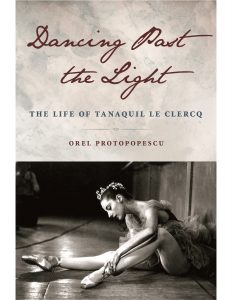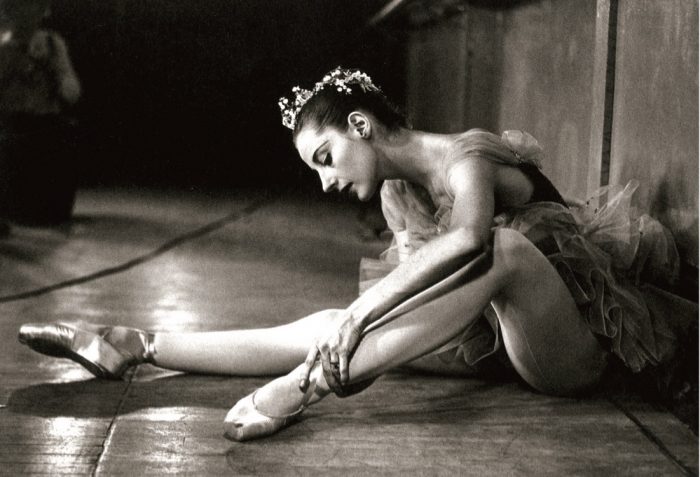Book Review: ‘Dancing Past the Light’
Reviewed by Jeffrey Sanzel
“Ballet is an ephemeral art, embedded in the mortal human body.”

Principal ballerina Tanaquil Le Clercq (1929-2000) was the fourth and final wife of choreographer and founder of the New York City Ballet, George Balanchine. Tanaquil—known as “Tanny”—was a muse to Balanchine as well as the genre-crossing Jerome Robbins. Both legendary artists created immortal works for Le Clercq. At twenty-seven, she contracted polio, ending her career as a dancer but not her connection to the art of dance.
Illustrated by 100 photos, Dancing Past the Light (University Press of Florida) is a fascinating account of Le Clercq—her vocation, her challenges, and the underlying strength and humanity that allowed her to triumph in the face of a devastating illness. Author Orel Protopopescu provides almost a dual biography of Le Clercq and Balanchine, two lives that remained inseparable even after their divorce.
Le Clercq descended from affluent, educated people: “On both sides, Tammy’s immediate ancestors were adventurous, artistic, worldly, and liberal-minded for their times.” However, her parent’s fiscal situation was tenuous. Her St. Louis debutante mother, Edith, was the driving force behind her early dancing, enrolling her at New York City’s King-Coit School. As a scholarship student in theatre and art, she performed for the first time at five years old. By age seven, she was studying at Mikhail Mordkin’s ballet school. She entered Balanchine’s School of American Ballet at age eleven, awarded one of the school’s first full scholarships.
Her acceptance to the school coincided with the final dissolution of her parent’s marriage, strained by her father’s excessive drinking. The couple separated in 1946. Her father would remarry; her mother would remain single and a constant if sometimes unwanted presence in Le Clercq’s life. “The umbilical cord had stretched a bit further over the years but was never severed.”
The author provides detailed accounts of the demanding training, the rehearsals, and especially the performances. She conveys Le Clercq as an artist-in-motion, and the descriptions are exceptional. Additionally, Protopopescu traces her rise in the company, balancing the personal and professional particulars with dozens of interviews with friends and colleagues.

At the center is her connection with Balanchine whom she saw as “an old fogey” until she began receiving more personal instruction. Balanchine was a demanding director, influencing every area of his dancers’ lives, particularly the female dancers.
Balanchine preferred “thin, tall female dancers with long necks and limbs.” Le Clercq epitomized this. While there were hints of Balanchine’s interest, by the time she was twenty, he was no longer hiding it. There were strong possibilities that he sabotaged or at least manipulated elements of her personal and romantic life.
The Le Clercq-Balanchine courtship and marriage are explored with great insight, including the complications rooted in the age difference and Balanchine’s need to seek a younger muse. Balanchine proposed Christmas 1952. She was twenty-three to his forty-eight. Without hesitation, she excepted, and they were married on New Year’s Eve. But, true to form, the work came first. They premiered the ballet Concertino the night before.
Le Clercq worked well and often with the mercurial and demanding Jerome Robbins. As with Balanchine, the complicated professional-personal relationship is surveyed with respect and candor and the complex triangle that existed between the three.
Protopopescu provides a visceral report of the European tour of 1956, during which Le Clercq contracted polio. At that time, her marriage to Balanchine was waning, and she had no desire to go. Following her contraction of the disease, Le Clercq faced a long recovery and the harsh reality of knowing that she would never dance again. “I’m not a dancer anymore. Who am I?” This was the question she faced after over two decades of dancing.
A brutal, vivid picture of a polio victim follows, showing both the physical and psychological pains and the life limitations. But it also shows Le Clercq transforming by fearlessly facing the problems. As her friend Pat McBride explained: “Her wit and strength never left her nor did she indulge in self-pity. It was always a treat to be in her vivacious company.”
Eventually, she coached and taught at Arthur Mitchell’s Dance Theatre of Harlem using hand gestures—“a sort of balletic sign language”—to convey the choreography while seated in her wheelchair. The author touches upon the issue of race in the dance world and the lack of diversity and underrepresentation of African-Americans in Balanchine’s company. While not an activist, Le Clercq’s work with the DTH spoke volumes.
Dancing Past the Light will be of particular interest to ballet fans; it is an extraordinary celebration of a life in dance, with its highs and lows, challenges and rewards. It is an honest study of the people with whom one makes art. It is also a beautiful, authentic portrait of an exceptionally strong individual who faced a cataclysmic shift and rose above it.
ABOUT THE AUTHOR:
A resident of Miller Place, Orel Protopopescu is an award-winning author, poet, and translator. Dancing Past the Light: The Life of Tanaquil Le Clercq is her first biography. Pick up a copy of the book at Amazon.com, or BarnesandNoble.com. For more information on the author, visit www.orelprotopopescu.com.







